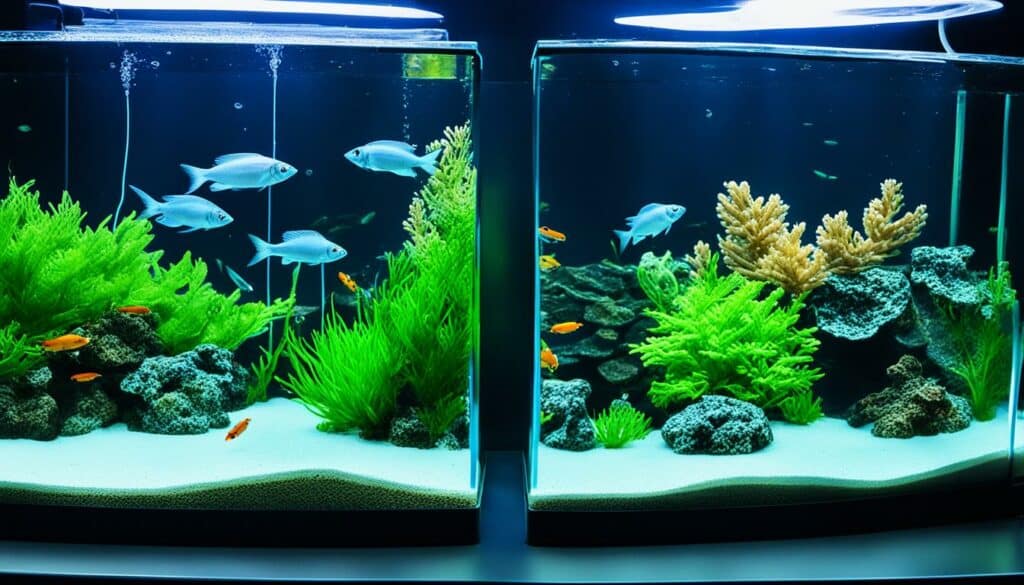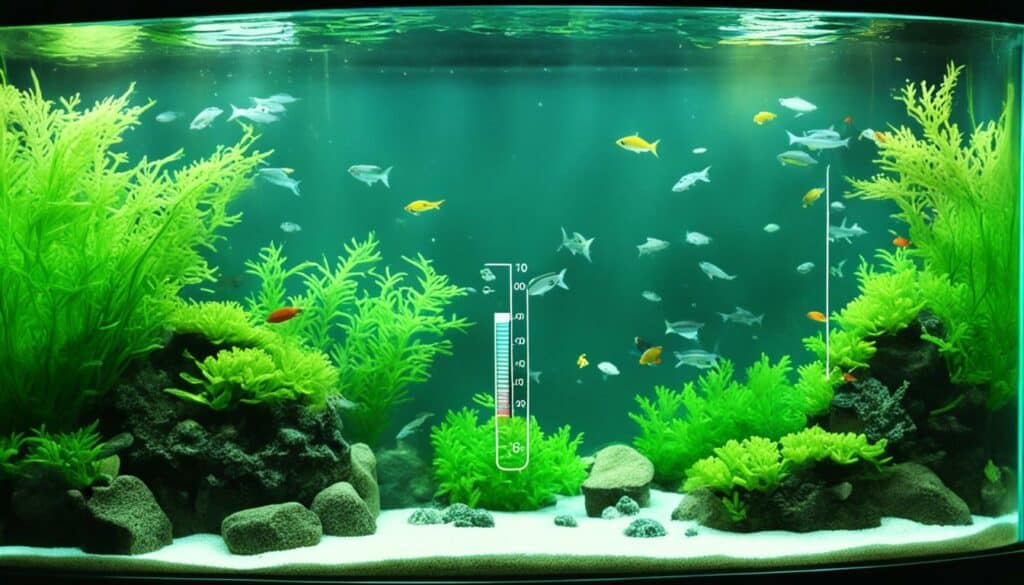Welcome to our guide on the optimal placement for aquarium heaters. If you’re a fish enthusiast, you know how important it is to maintain a consistent water temperature in your aquarium. The correct placement of your heater plays a crucial role in achieving this. In this guide, we will discuss the best locations for your aquarium heater and factors to consider when choosing the placement.
Key Takeaways:
- The best location for placing an aquarium heater is near the maximum water flow, such as the outlet (or inlet) from the filter, or in the stream of a powerhead.
- Water flowing directly past the heater ensures quick and even dispersal of heated water throughout the tank.
- Consider the size of your aquarium and choose a heater with 5 watts per gallon capacity of water to maintain the desired temperature.
- For larger tanks over 40 gallons, using two heaters placed at opposite ends of the tank is recommended for uniform water temperature and as a backup.
- Heat can be distributed through conduction, convection, and circulation in the tank.
Ideal Placement for Aquarium Heater
When it comes to the correct placement of your aquarium heater, positioning it near the water flow is crucial for ensuring optimal heat distribution. Placing the heater near the outlet of the filter or a powerhead allows the heated water to disperse evenly throughout the tank.
To maintain a stable temperature in your aquarium, avoid placing the heater near the water surface or substrate. These areas can experience temperature fluctuations, which may negatively impact the health of your aquatic pets. Instead, position the heater horizontally just above the gravel or substrate.
If you are using a partially submersible aquarium heater, you can enhance heat distribution by placing an air stone under it. The air stone helps draw cool water towards the heat source, promoting efficient circulation and temperature regulation.
For more flexibility in placement, it is advisable to opt for a fully submersible aquarium heater. This type of heater can be positioned at different depths within the aquarium for optimal heat distribution.
Remember, maintaining a balanced temperature in your aquarium is essential for the well-being of your fish and other aquatic inhabitants. By taking the time to position your heater correctly, you can create an ideal environment for your underwater friends to thrive.
Factors to Consider for Heater Placement
When deciding on the placement of your aquarium heater, there are several factors you should take into consideration to ensure its proper functioning and the well-being of your aquatic pets. These factors include:
- Size of the aquarium: The size of your aquarium plays a role in determining the appropriate placement of the heater. Larger tanks may require multiple heaters to provide uniform heat distribution.
- Water circulation: Placing the heater near areas of water flow, such as the outlet of the filter or a powerhead, helps in distributing the heat evenly throughout the tank.
- Placement of other equipment: Consider the placement of other equipment in your aquarium, such as rocks, decorations, and plants. Ensure that the heater is placed in a location where it won’t be obstructed or covered.
- Availability of space: Take into account the available space in your aquarium for heater placement. Make sure there is enough room for the heater and that it doesn’t come into direct contact with any tank inhabitants.
- Visibility: While you want to ensure proper heat distribution, you may also want to consider the aesthetics of your aquarium. Decide whether you prefer a more visible or discreet placement of the heater.
By considering these factors and finding the optimal placement for your aquarium heater, you can create a comfortable and stable environment for your fish and other aquatic organisms.
“The placement of your aquarium heater plays a crucial role in maintaining the ideal temperature for your aquatic pets. Consider the size of your tank, water circulation, placement of other equipment, availability of space, and visibility when deciding on the optimal location.”
With proper heater placement and regular monitoring, you can ensure that your aquarium provides a suitable habitat for your fish, promoting their health and well-being.
Now that we’ve explored the factors to consider for heater placement, let’s delve into the differences between horizontal and vertical placement in the next section.
Horizontal vs Vertical Placement
When it comes to placing your aquarium heater, you have the option of both horizontal and vertical placement. Each has its advantages and considerations, so let’s explore both options to help you make an informed decision.
Horizontal Aquarium Heater Placement
Horizontal placement of the heater is known for its ability to provide more even heat distribution throughout the tank. By placing the heater horizontally, you can ensure that the heated water is circulated and dispersed effectively. This helps to maintain a consistent temperature across the entire aquarium, which is important for the well-being of your aquatic inhabitants.
However, it’s worth noting that horizontal placement may make the heater more visible inside the tank. While some aquarists don’t mind the appearance, others prefer a more aesthetically pleasing setup. If you’re particularly conscious of the heater’s visibility, you may want to explore alternative placement options.
Vertical Aquarium Heater Placement
Vertical placement of the heater offers a more discreet option that can be appealing from an aesthetic standpoint. Placing the heater vertically along the tank’s back or side can help to minimize its visibility, creating a cleaner and more visually appealing aquarium setup.
However, it’s crucial to ensure that the heater remains fully submerged at all times when placed vertically. This ensures proper functionality and prevents any potential hazards. Always refer to the manufacturer’s instructions to determine the recommended submersion level for vertical placement.
Ultimately, the decision between horizontal and vertical placement depends on your personal preferences, the desired aesthetics of your aquarium, and the specific recommendations from the heater manufacturer.
| Placement Option | Advantages | Considerations |
|---|---|---|
| Horizontal Placement | More even heat distribution | Increased visibility |
| Vertical Placement | Discreet and aesthetically pleasing | Ensure full submersion |

Checking if the Aquarium Heater is Working Properly
Ensuring that your aquarium heater is functioning correctly is crucial for maintaining a stable and comfortable environment for your aquatic pets. Here are some steps to help you determine if your aquarium heater is working as it should:
- Check the power indicator light: When the heater is plugged in and powered on, the power indicator light should be illuminated. This confirms that the heater is receiving power and should start heating the water.
- Monitor water temperature: Use a thermometer to regularly check the water temperature. The temperature should gradually rise and remain stable within the desired range set on the heater.
- Observe heat generation: Pay attention to the heater and check if it is generating heat, specifically the heating element. If the heater feels warm to the touch, it indicates that it is functioning properly.
- Adjust set temperature: Verify the set temperature on the heater and make adjustments if necessary. Ensure that the desired temperature aligns with your specific aquarium requirements.
- Monitor fish behavior: Keep an eye on the behavior of your fish. Lethargy, reduced appetite, or unusual behavior may be indicators of inappropriate water temperature. Always be attentive to any signs of distress in your aquatic pets.
If you encounter any issues with your aquarium heater or suspect that it may not be working correctly, it is advisable to consult the manufacturer’s instructions or seek professional assistance. Maintaining a properly functioning heater is essential for the well-being of your fish and the overall health of your aquarium environment.

Conclusion
Properly placing your aquarium heater is crucial for maintaining a balanced aquatic environment. By positioning the heater near the water flow, such as the outlet of the filter or a powerhead, you can ensure even heat distribution throughout the tank. This optimal aquarium heater placement creates the perfect conditions for your fish to thrive.
In addition to the correct placement of the aquarium heater, it is important to consider factors such as water circulation and space. Having water flowing directly past the heater helps to quickly and evenly disperse heated water throughout the tank, promoting uniform temperature. It is also recommended to choose a heater with an appropriate wattage for your tank size, such as 5 watts per gallon.
Regularly monitoring the functionality of your aquarium heater is essential to maintain the correct water temperature. Ensure the power indicator light is on when the heater is plugged in and powered on. Use a thermometer to monitor the water temperature and make adjustments if necessary. If you notice any unusual behavior in your fish, it may indicate an issue with the water temperature.
Remember to consult the manufacturer’s instructions for specific placement recommendations and seek professional advice if needed. With the correct placement and care, your aquarium will provide a healthy and vibrant underwater habitat for your aquatic pets.
FAQ
Where should I place my aquarium heater?
The best location for an aquarium heater is near the maximum water flow, such as the outlet from the filter or a powerhead. This ensures even heat distribution throughout the tank.
Can I place the heater near the water surface or substrate?
It is important to avoid placing the heater near the water surface or substrate to prevent temperature fluctuations. The heater should be positioned horizontally just above the gravel or substrate.
Should I use a partially submersible or fully submersible heater?
It is advisable to use a fully submersible heater for more flexibility in placement. However, if using a partially submersible heater, placing an air stone under it can help draw cool water to the heat source.
Should I place the heater horizontally or vertically?
Aquarium heaters can be placed both horizontally and vertically. Horizontal placement can result in more even heat distribution throughout the tank, while vertical placement may be preferred for aesthetic reasons. Ensure that the heater is fully submerged at all times.
How do I know if my aquarium heater is working properly?
To check if your aquarium heater is functioning properly, first, ensure that the power indicator light is on when the heater is plugged in. Use a thermometer to monitor the water temperature and ensure it gradually rises and remains stable. Observe the heater to see if it is generating heat, especially the heating element. Check the set temperature on the heater and make adjustments if necessary. Monitor your fish’s behavior, as lethargy or unusual behavior may indicate an issue with the water temperature.
What factors should I consider when placing my aquarium heater?
When deciding on the placement of your aquarium heater, consider factors such as water circulation, the size of the tank, and the manufacturer’s instructions for the most efficient placement of the heater.











